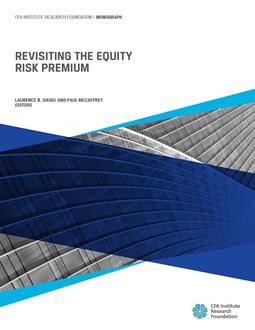Held once a decade since 2001, the Equity Risk Premium Forum gathers leading investment minds to discuss new ERP research and key trends. The 2021 consensus was lower expected returns in the future.
The publication includes contributor updates from 2023.

Overview
In 2001, Martin Leibowitz organized an Equity Risk Premium (ERP) Forum for CFA Institute, in which the participants discussed issues related to the ERP and made estimates for the future. This forum was repeated by Leibowitz, Brett Hammond, and Laurence Siegel in 2011, setting a precedent for a decennial forum. Siegel organized and moderated the discussion in 2021, and the proceedings from that event make up the current book.
The participants in 2021 were (in alphabetical order) Robert Arnott, Clifford Asness, Mary Ida Compton, Elroy Dimson, William Goetzmann, Roger Ibbotson, Antti Ilmanen, Martin Leibowitz, Rajnish Mehra, Thomas Philips, and Jeremy Siegel. Each participant made a presentation, which was then discussed by the whole group. Finally, a roundtable discussion involving all of the participants was moderated by Laurence Siegel.
Ibbotson and Dimson discussed historical returns in different countries. Ibbotson focused on the United States, while Dimson took a global industrial-country view. The history goes back almost a century (Ibbotson) or more than a century (Dimson), providing a look at how returns have evolved over a wide variety of conditions. Ibbotson also presented his method for making probabilistic forecasts of returns. Dimson, who is British, showed that “American exceptionalism” is one way to understand the results.
Asness looked at the effectiveness of Robert Shiller’s CAPE (cyclically adjusted price-earnings ratio) valuation measure for forecasting. Valuations rose over the period he studied, and a lively discussion was had about why this may have occurred. Arnott focused on the growth rate of dividends, which has been very slow in per-share terms, and argued (with much debate from the other participants) that buybacks are only a partial substitute for dividends. Leibowitz, also looking at valuation as the lodestone of return forecasts, set forth a “growth adjustment” that brought his forecast in line with those made by others.
Compton, a consultant to pension plans, discussed the challenges of communicating lower expected returns to clients. She also emphasized that expected returns “don’t always come true,” they’re just someone’s best forecast.
Ilmanen broke up the expected return into its component parts: dividends, real growth, inflation, and so forth. Doing this, he said, allows one to debate the estimates for each part and ascertain how accurate each of the estimates is. Philips started by presenting a method for forecasting bond returns. He then turned to equities, for which he compared forecasts with subsequent realizations using a variety of forecast methods.
Mehra discussed a number of issues related to the existence of premiums (equity risk, value, small cap, and so forth) and concluded that, although some of these are unstable, the ERP is highly stable. Jeremy Siegel advocated a “back to basics” approach using dividend and earnings yields, dividend and earnings growth rates, payout ratios, and price-to-earnings ratios. He emphasized that earnings can be calculated in a number of different way, and said that accounting practices have become more conservative over the years.
Goetzmann concluded the session by reporting that one company, a water mill in France, had almost 600 years of historical return data and that an asset pricing model could be tested using those data. According to this model, the stock price is the present value of expected future dividends and is supported by the evidence.
In sum, because of high valuations and low interest rates, the participants expect lower total returns in the future than in the past. A forward-looking ERP of 4% to 5% was the consensus of the group.
